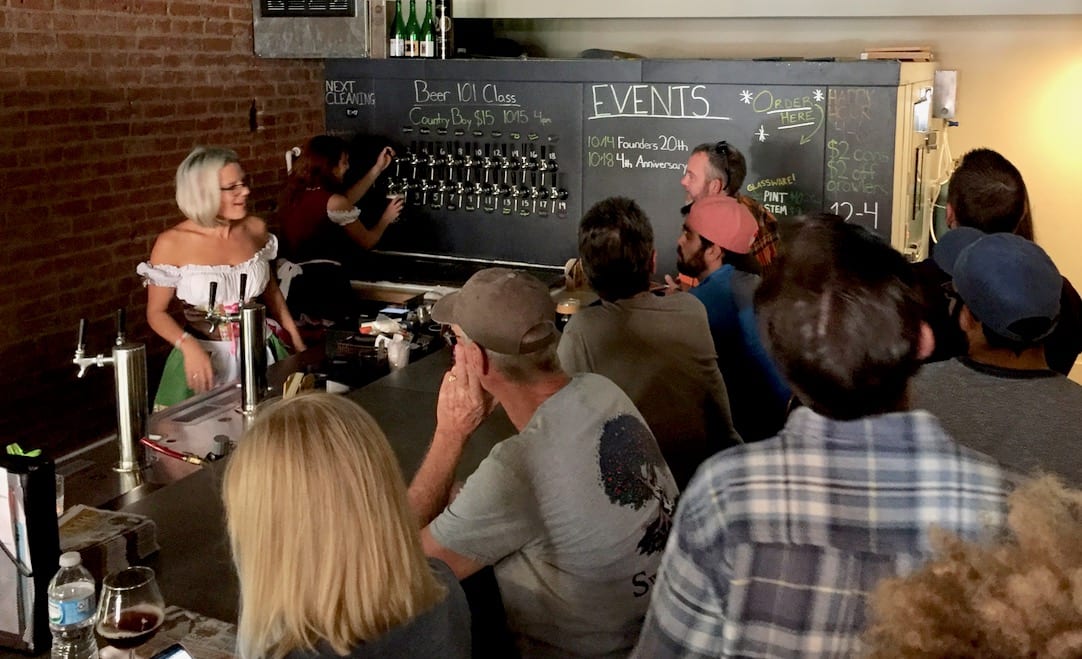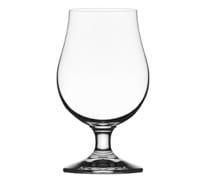
So you want to be a craft beer bar
October 19, 2017
My apologies to songwriters Chris Hillman and Roger McGuinn of The Byrds for my rewrite of their song So You Want To Be a Rock ‘N’ Roll Star.
So you want to be a craft beer bar
Then listen now to what I say.
Just get a copy of Tasting Beer
Memorize the lines
And learn how to play.
And when your beer pours right
A tap takeover night
Will surely make it all right.
Then it’s time to go across town
To the distributor man who won’t let you down
But stay away from that InBev gear
Unless you want to be known for selling plastic beer.
And in a month or two
You’ve got your list on Untappd
The crowds will keep it packed.
The price you paid for that keg was insane.
You may not make it back
But it’s all in the game.
The snobs, the fans, and the geeks who came.
They won’t forget what you are.
You’re a craft beer bar.
La, la, la, la, la, la, la, la, la
[youtube https://www.youtube.com/watch?v=qMaJWESoZlk?rel=0&showinfo=0&start=20&w=560&h=315]
Eleven rules for craft beer bars
Okay. Here’s the thing. It’s a whole lot more complicated than it seems.
West Virginia came late to the craft beer game, and that likely goes a long way toward explaining why we have so few real craft beer specialty bars. Oh, we have our share of posers and wannabes, but we have few who make the grade. Those few, however, are great examples of how to make it work in West Virginia.
 [The opening photo for this article was taken at Summit Beer Station in Huntington, WV — one of those bars that gets it and does things right.]
[The opening photo for this article was taken at Summit Beer Station in Huntington, WV — one of those bars that gets it and does things right.]
Here are Brilliant Stream’s eleven rules for craft beer bars, that if followed, will put you at the head of the class.
1. Have a knowledgeable lead on staff
If you don’t have the background yourself, hire someone with solid craft beer knowledge to take the lead in developing your concept and curating your selections. It’s best if this person is managerial level, but it can even be a contracted consultant. When hiring a beer manager, look for signs of expertise, things like Certified Cicerone or Beer Judge certification.
Too many bars make the mistake of letting their distributors pretty much determine their beer lists because the owners and managers are not knowledgable enough or energetic enough to do it themselves. The tap selection at a craft beer bar doesn’t just happen; it’s curated.
Consult with your local craft beer and homebrew clubs to get recommendations of people with solid craft beer knowledge.
2. Train your people
There’s nothing worse than going into a bar with 25 taps and having a server who can’t tell me anything about the beer. Don’t give me a PhD tap selection and a grade-school dropout bartender. Train all your staff in basic beer science and styles, and in proper beer handling and service.
Don’t send out to the floor or put behind the bar any employee to take beer orders who has not completed your basic orientation and product training session — unless that staffer is shadowing an experienced employee as part of his or her training. It’s best to have your staff demonstrate their general beer knowledge by having passing the Certified Beer Server level of Cicerone, or Beer 101 Course at CraftBeer.com, or another similar training certification program.
Once completing your initial orientation and training program, new hires can be given a short period of time to pass your chosen basic exam. (Yes, you pay/reimburse them for the test fee.) Until servers and bartenders have passed the test, consider maintaining them as probationary employees.
Having high standards for your staff will attract a more dedicated, intelligent and knowledgable employee who will be proud of being a part of something extraordinary. Good people want to work in the best places. Make your bar one of them.
3. Offer beer in appropriate glassware
If you want to be a true craft beer bar, get some decent glassware for tasting beer. For crying out loud. And I don’t mean mugs, shaker pints, or mason jars. Sure, appropriate glassware costs some extra bucks, but your customers deserve a better drinking experience.

A classic beer tulip glass is a great option for serving craft beer. So are most inward curving glassware. The somewhat bowl-shaped design not only looks good, it captures and serves up the beautiful aromas of hops, malt, and fermentation that the brewer wants us to experience.
Slope-sided shaker pint glassware does not belong in a craft beer bar. Yes, I know it’s sturdy, cheap, and easy to get. But it’s proven that beer does not taste as good when drunk from a shaker pint as it does from an appropriate craft beer glass.

Always sell your beer by sizes clearly designated by the number of ounces you get. An important feature to find on beer glassware is a mark designating the pour size. If you are normally selling by the pint, there can be a 16 oz. fill-line on the glass. There should always be extra head space above the fill line. The same glass can have multiple marks for lesser amounts, such as 4 oz. and 8 or 10 oz. That way, one glass covers different pour sizes. If you do not have pour lines on your glassware, then you should offer at least three sizes of glassware. One for flights/samples. a half-pour size and a full pour size — each advertised by the number of ounces it contains.
All beer glasses need head space above the pour size. If you are selling a 16-oz. beer, you need a glass that holds 18 ounces or more as a rule of thumb. Otherwise there is no head space for a perfect pour. If you only have a 16-oz. glasses, then it’s wise to clearly advertise your pours as 14 ounces.


If you are caught selling cheater pints, you should be boycotted and banished from the craft beer world. A cheater pint is any glass holding less than 16 oz. (one pint) that a bar tacitly sells as a pint without disclosing to the customer that the glass actually holds less than a pint.
If you give me the bottle or can of the beer I ordered without a giving me a glass to drink it from, you are totally ignorant of beer enjoyment protocols. Drinking from a can or bottle is for camping trips, pool halls, and tailgate parties. To get the full flavor and drinking experience that the special beer provides, a craft beer should always be poured into and drunk from a glass.
Unless the beer is sold to-go, assume all customers want an appropriate glass for their beer. Always. Then, properly pour the beer into the glass as part of the service ritual. It’s also smart to offer the customer the can or bottle since craft beer labels often have details about the beer that customer would enjoy seeing.
4. Serve beer at the proper temperature
If I ever get a frozen glass at your bar, I will lose all respect for your craft beer knowledge. Craft beer is never served in a frozen glass unless you want to destroy the drinking experience. Icy cold temperatures absolutely dull the aroma hops, malt, and fermentation flavors in a beer. That may be appropriate for Bud Light and other cheap lagers, where you really don’t want people tasting the beer anyway.
Craft beer needs a room temperature glass because it should be served warmer than Corona-Bud-Miller-Coors. An important part of warming it up when pouring from an icy-cold tap system is pouring it into a room temperature glass. Warmer temperatures allow the flavors in a craft beer to bloom. Those are the flavors the brewer specifically put into the beer for you to enjoy. Don’t kill them by serving the beer ice cold.
The default temperature for modern draft beer refrigeration equipment is set to icy cold. It’s not wise to mess with that unless you are very draft beer system proficient and handy. However, for your bottled and canned beer, you can set your beer cooler/cold box temperature a little warmer than ice cold. Around 40º F is about as cold as you want to store lighter craft styles. Darker, heavier beer styles need even warmer temperatures to show properly, so you can store bottles of those in a less cold refrigerator /section.
5. Stratify your beer selections
Have a plan for your tap selection. Offering good craft beer draft selections is not just about having the latest, greatest beers you can get without thought of having balance in your selections. Think through your selections and always offer a wide variety and balance to your beer list. Vary it with the seasons.
Not every craft drinker wants a total diet of the latest big IPAs, imperial stouts, 10+ percenters, and whiskey-barrel-aged specialties. Keep a variety of styles on your taps, including several that are relatively easy drinking and lower alcohol. West Virginia is not a large enough market for a craft beer bar to only feature the biggest, boldest, baddest brews.
Experienced craft beer drinkers often look for and appreciate a more a subtle beer flavor experience than you can get in an imperial strength or whiskey-driven or hop-juice dominated beer. Craft beer newbies also need craft beers with subtler flavors that don’t shock their taste buds, yet get them enjoying and better understanding the incredible variety craft beer provides.
Use tap takeovers and other special events to temporarily vary from your balanced approach. Use these events to build your craft beer credibility with extreme beer, but then return to your balanced approach.
Determining which beers you will offer should be a serious undertaking. Don’t offer a beer just because it’s new or because a customer asked for it. Don’t offer a beer just because a distributor is pushing it. Don’t offer a beer just because it’s from a local brewery. Don’t offer a beer that you haven’t tried and haven’t written a description of so you know where it fits in your tap stratification philosophy.
Ensure that every beer meets your taste standards and fits your tap strategy plan. Taste every beer before you buy it for your bar. Honestly, there are plenty of middling beers out there from national, regional, and local breweries. Gimmick beers abound these day. Mediocre copycat beers are everywhere. You don’t need them. Find the best examples of the styles you want and buy them. You need to know the difference. Be able to tell your customers why you decided to put a specific beer on tap or decided not to put another one on. Do seek input from you staff and customers, but make the final decision based on the beer’s quality and how it would fit your business plan.
6. Use “Beer-Clean” glassware
If you pour me a beer and the head goes away quickly or lots of bubbles adhere to the sides of the glass, I know immediately that the bar does not practice “Beer-Clean” protocols for its glassware. Craft beer bars must offer only beer-clean glassware. No excuses.
Sanitizing glassware to meet the health code is not necessarily making it beer-clean. Beer clean is a higher standard.
Beer clean means you follow a specific protocol for washing, rinsing, and drying your beer glassware. You take it seriously. You keep the contents of your washing, sanitizing and rinsing sinks fresh. You know to never polish your glasses with a towel. You work with your cleaning chemical supplier to ensure you support the beer-clean protocol.
7. Clean your draught beer lines often
We’ve got a pretty big problem with dirty beer lines in West Virginia bars. A craft beer bar must be held to the highest standard for beer line cleanliness. It’s not optional.
True craft beer bars take responsibility for their own beer line cleaning. It’s so important. True craft beer bars buy their own cleaning equipment or contract a private cleaning service and set up a strict protocol and schedule for cleaning and sanitizing. They stick to this protocol religiously.
There is absolutely no excuse for tainted or infected beer to ever be served in a craft beer bar. Clean your own lines and do it right — including cleaning between beer switches on a tap.
8. Use bottled or canned beer to complement your tap list
It’s less expensive and easier to add variety to your beer list with bottled and canned beer than it is to add a bunch more taps. So use the availability of these to your advantage. Beers that are traditionally bottle conditioned are actually better when poured from a bottle. Know which beers those are and feature them more often in bottles than on draught. Craft consumers today are also very tuned in to buying canned beer, and they appreciate the advantages canning provides.
While buying packaged beer a case at a time may not seem like a lot, it can quickly add up to a lot of inventory.As in your draft selections, you need a solid plan for your cans and bottles. Carefully stratify and control your bottle selection. You’ll move inventory much faster if you don’t have unnecessary style duplication. If you’ve purchased beers in line with your plan, you’ll have only the best examples of beers of the specific styles you want to carry. You’ll be careful not to add many more similar beer until the ones you already stock are nearly sold-out. When purchasing another case of a beer you already stock, you’ll be sure to rotate the old stock to the front rows of the cooler.
9. Maintain an up-to-date beer list
A true craft beer bar always has an accurate, accessible draft and bottle list available. It’s impossible for a bar with 50 or more beer selections to sell them properly without a list. No server or bartender can be expected to recite all those selections to a customer.
Your list can be printed on paper, shown on a large TV screen, put up on your website/Facebook page, or listed on Untappd or similar service.
Always list both draft and bottle selections. Organize your list to help customers find a beer that is right for them. Always put serving sizes, ABV, and prices on your list. Use your list to highlight features and promotions.
10. Use a consistent pricing strategy that reflects underlying cost
With contemporary point-of-sale systems, there is no reason not to use a standard mark up and vary beer pricing with the underlying cost of the beer. Craft customers well know that craft beer varies considerably in cost. They never expect all draft to be the same price.
Having a one-price policy for draft invariably ends up penalizing those craft beer producers that offer lower pricing by making them subsidize the higher priced lines. It’s not fair. Set your standard mark up, then apply it to the cost of every beer, rounding up to the next nickel, dime or quarter. Price variation is a good thing and leads the customer to believe that this bar really understands beer.
Price variation also provides the opportunity for the bar staff to up-sell. American consumers often use price as a proxy for quality. In the absence of other information, the higher priced product is assumed to be the better one. For example, having two IPAs with one a dollar higher in price, gives the bartender/server the chance to point out the special qualities of the higher priced beer. Moving more higher priced beer adds dollars to the bar’s gross profit and likely to the server’s gratuity.
11. Beer is perishable – Keep it fresh
Very, very few beers improve with age. Beer is normally released by the brewery when it is ready to drink. Lighter tasting ale styles and big-hopped beers are two examples of beer that may lose their quality pretty quickly.
For a craft beer bar in West Virginia who wants to make money, you should specialize in selling beer, not aging it.
Inform your distributors that you want only the freshest beer. If the production date is not written on the keg collar or bottle/can, ask the distributor to get that date from the brewery for you before you purchase the beer. Inspect the dates carefully as your beer is delivered to make sure it’s what you ordered and it’s fresh. Refuse any beer that is already older than it should be for best quality.
Once beer is in your cooler/cellar, have a plan for selling it while it is in top condition. Don’t lose beer in the back of the cooler. Because local craft beer is rarely pasteurized, it needs to be kept chilled at all times. This helps it maintain freshness and helps keep any unwanted bacterial/yeast contamination from spoiling the beer.
A good rule of thumb is to ensure that your blonde ales, standard-strength lagers, hop-driven selections, and any other beer with an alcohol strength under about 6.5% are sold by the end of the third month after bottling/kegging. Program your beers accordingly. As its sell-by date approaches, put a beer on promotion and be sure you sell it out while it’s in top condition.
So you want to be a craft beer bar? There’s no reason why you can’t. Just observe these 11 rules and see your bottom line grow.


